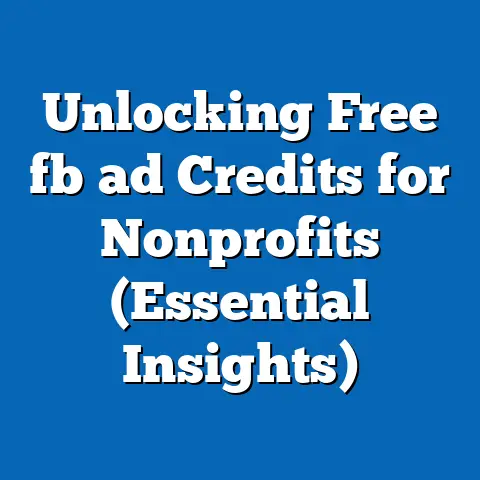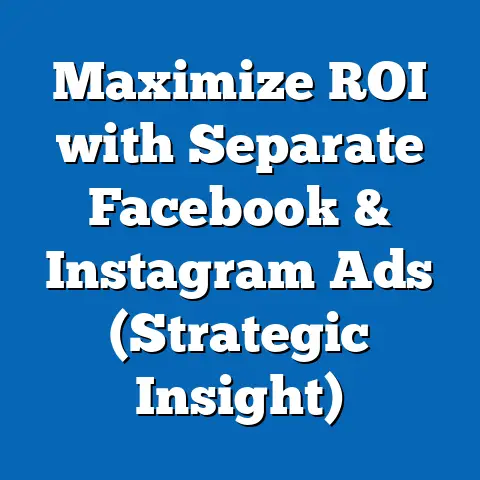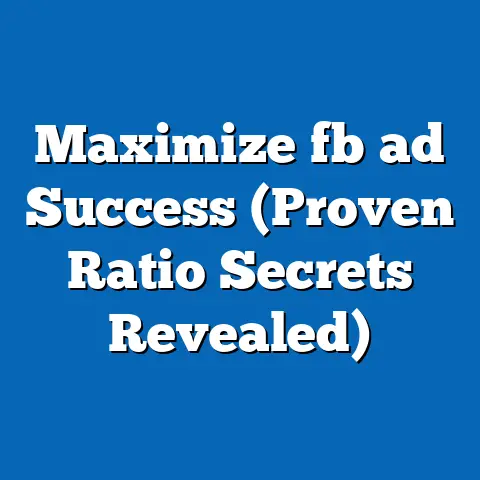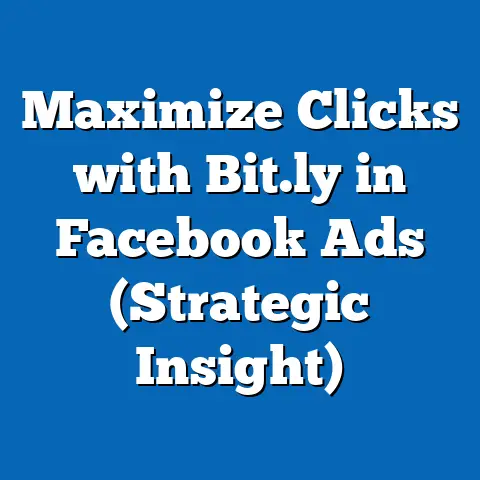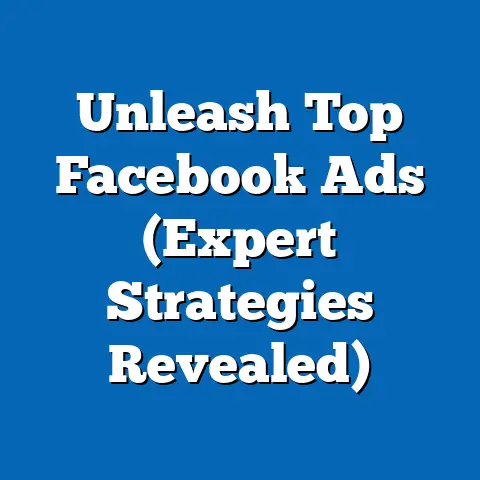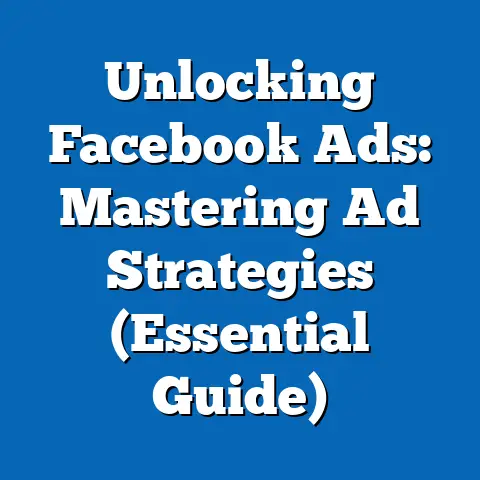Download My Facebook Strategy (Proven Success Guide)
In today’s fast-paced digital world, technology is constantly evolving, reshaping how we connect, communicate, and conduct business. This rapid evolution has profoundly impacted marketing strategies, particularly in the realm of social media advertising. The rise of platforms like Facebook has transformed the landscape, offering businesses unprecedented opportunities to reach and engage with their target audiences.
I remember when I first started diving into Facebook ads, it felt like navigating a maze. There were so many options, metrics, and strategies that it was easy to get lost. But over time, through trial and error, and countless hours of research, I developed a Facebook marketing strategy that consistently delivered results.
Now, advancements in data analytics, machine learning, and AI-driven tools have further empowered businesses to optimize their advertising efforts on Facebook. These technologies provide invaluable insights into consumer behavior, preferences, and trends, enabling marketers to craft more targeted and personalized campaigns.
However, with great power comes great responsibility. Without a structured approach and a clear understanding of the platform’s nuances, businesses risk wasting time, money, and resources on ineffective advertising initiatives. That’s why I’ve created this guide, to help you develop a proven Facebook marketing strategy that will drive real results.
The Importance of a Structured Facebook Marketing Strategy
In the dynamic and competitive landscape of Facebook, a well-defined marketing strategy is not just an advantage; it’s a necessity. I’ve seen firsthand how businesses that approach Facebook advertising haphazardly often struggle to achieve their desired outcomes. A structured strategy provides a roadmap for success, guiding your actions and ensuring that your efforts are aligned with your overall business objectives.
Why is a strategy so crucial?
- Standing Out in the Crowd: Facebook is a crowded marketplace, with millions of businesses vying for attention. A strategic approach allows you to differentiate yourself from the competition and capture the attention of your target audience.
- Maximizing ROI: A well-defined strategy ensures that your advertising budget is allocated effectively, maximizing your return on investment (ROI).
- Achieving Measurable Results: A structured strategy includes clear goals and objectives, allowing you to track your progress and measure your success.
- Staying Ahead of the Curve: The Facebook advertising landscape is constantly evolving. A strategic approach allows you to adapt to changes and stay ahead of the curve.
Key Elements of a Facebook Marketing Strategy:
- Audience Targeting: Identifying and understanding your target audience is the foundation of any successful Facebook marketing strategy.
- Content Planning: Creating engaging and relevant content that resonates with your audience is essential for building brand awareness and driving conversions.
- Budget Allocation: Determining how much to spend on Facebook advertising and how to allocate your budget across different campaigns is crucial for maximizing ROI.
- Ad Creative: Crafting compelling ads that capture attention and drive action is essential for achieving your advertising goals.
- Campaign Optimization: Continuously monitoring and optimizing your campaigns based on data-driven insights is crucial for improving performance and maximizing ROI.
My Experience:
I once worked with a client who was struggling to generate leads on Facebook. They were running ads, but they weren’t seeing any results. After analyzing their campaigns, I realized that they didn’t have a clear understanding of their target audience. They were targeting everyone, which meant they were wasting a lot of money on ads that weren’t relevant to anyone.
By working with them to define their target audience and create more targeted ads, we were able to dramatically improve their lead generation efforts. This experience reinforced the importance of having a well-defined Facebook marketing strategy.
Takeaway:
A structured Facebook marketing strategy is essential for success on the platform. It provides a roadmap for your actions, ensures that your efforts are aligned with your business objectives, and helps you maximize your ROI.
Understanding Your Target Audience
Knowing your audience is paramount to the success of any marketing endeavor, and Facebook is no exception. In fact, with Facebook’s sophisticated targeting capabilities, understanding your audience becomes even more critical. I’ve found that the more you know about your audience, the more effectively you can reach them and the more likely you are to achieve your marketing goals.
Why is Audience Understanding So Important?
- Relevance: By understanding your audience’s interests, demographics, and behaviors, you can create ads that are highly relevant to them.
- Engagement: Relevant ads are more likely to capture attention and generate engagement, leading to higher click-through rates and conversion rates.
- Efficiency: By targeting your ads to the right people, you can avoid wasting money on ads that are irrelevant to your audience.
- Personalization: Understanding your audience allows you to personalize your ads and messaging, making them more appealing and effective.
How to Research and Segment Your Audience:
- Facebook Audience Insights: This powerful tool provides valuable insights into the demographics, interests, and behaviors of people on Facebook.
- Facebook Pixel: By installing the Facebook Pixel on your website, you can track the actions that people take on your site and use this data to create more targeted audiences.
- Customer Data: Leverage your existing customer data, such as email lists and purchase history, to create custom audiences on Facebook.
- Surveys and Polls: Conduct surveys and polls to gather direct feedback from your target audience and gain a deeper understanding of their needs and preferences.
Creating Buyer Personas:
Buyer personas are fictional representations of your ideal customers. They are based on research and data about your existing and potential customers. Creating buyer personas helps you to:
- Understand Your Customers: Buyer personas provide a deeper understanding of your customers’ needs, motivations, and pain points.
- Target Your Marketing Efforts: Buyer personas help you to target your marketing efforts more effectively by identifying the channels and messages that resonate with your ideal customers.
- Create More Effective Content: Buyer personas help you to create more effective content by providing insights into the topics and formats that your ideal customers are interested in.
Example:
Let’s say you’re selling organic skincare products. Your buyer persona might be “Eco-Conscious Emily,” a 30-year-old woman who is passionate about sustainability and healthy living. She’s active on social media, follows eco-friendly influencers, and is willing to pay a premium for high-quality, organic products.
By understanding Emily’s motivations and preferences, you can create Facebook ads that specifically appeal to her, highlighting the organic ingredients and sustainable practices used in your skincare products.
My Experience:
I once worked with a local bakery that wanted to increase its Facebook advertising reach. Initially, they were targeting broad demographics with generic ads. After conducting thorough audience research using Facebook Audience Insights, we discovered that their ideal customers were primarily local residents, particularly young families and college students.
We then created targeted ads showcasing their delicious treats and highlighting special offers for these specific groups. The result was a significant increase in ad engagement and foot traffic to the bakery.
Takeaway:
Understanding your target audience is the cornerstone of a successful Facebook marketing strategy. By researching and segmenting your audience, creating buyer personas, and leveraging Facebook’s targeting features, you can create more relevant, engaging, and effective ads.
Crafting Compelling Ads
Once you have a solid understanding of your target audience, the next step is to craft compelling ads that capture their attention and drive action. I’ve learned that the key to creating high-performing Facebook ads lies in combining captivating visuals, persuasive copy, and a clear call-to-action.
Elements of High-Performing Facebook Ads:
- Visuals: Use high-quality images or videos that are visually appealing and relevant to your target audience.
- Copy: Write clear, concise, and persuasive copy that highlights the benefits of your product or service.
- Call-to-Action: Include a clear and compelling call-to-action that tells people what you want them to do, such as “Learn More,” “Shop Now,” or “Sign Up.”
- Relevance: Ensure that your ad is relevant to your target audience and their interests.
- Value Proposition: Clearly communicate the value proposition of your product or service, highlighting what makes it unique and desirable.
Exploring Facebook Ad Formats:
Facebook offers a variety of ad formats to choose from, each with its own strengths and weaknesses. Understanding the different ad formats and when to use them is crucial for maximizing the effectiveness of your campaigns.
- Image Ads: Simple and effective, image ads are a great way to showcase your product or service with a single, compelling image.
- Video Ads: Video ads are highly engaging and can be used to tell a story, demonstrate a product, or share a testimonial.
- Carousel Ads: Carousel ads allow you to showcase multiple images or videos in a single ad, making them ideal for highlighting a range of products or features.
- Collection Ads: Collection ads are designed to drive sales by showcasing a selection of products in a visually appealing format.
- Lead Generation Ads: Lead generation ads make it easy for people to sign up for your email list or request more information about your product or service.
Real-Life Examples:
- Nike: Nike’s Facebook ads often feature stunning visuals of athletes in action, accompanied by inspiring copy that encourages viewers to “Just Do It.”
- Airbnb: Airbnb’s Facebook ads showcase beautiful homes and unique travel experiences, appealing to people’s desire for adventure and exploration.
- Dollar Shave Club: Dollar Shave Club’s Facebook ads use humor and wit to promote their affordable shaving products, making them relatable and memorable.
My Experience:
I once worked with a client who was launching a new mobile app. We decided to use video ads to showcase the app’s features and benefits. We created a short, engaging video that demonstrated how the app could solve a common problem for their target audience.
The video ad was a huge success, generating a high click-through rate and a significant number of app downloads. This experience highlighted the power of video ads in capturing attention and driving action.
Takeaway:
Crafting compelling Facebook ads is essential for capturing attention, driving engagement, and achieving your advertising goals. By using high-quality visuals, persuasive copy, a clear call-to-action, and the right ad format, you can create ads that resonate with your target audience and deliver results.
Leveraging Facebook Insights and Analytics
Facebook Insights and Analytics are invaluable tools for tracking ad performance, understanding audience engagement, and refining your advertising strategy. I’ve found that by regularly monitoring these metrics and using them to inform your decisions, you can significantly improve the effectiveness of your Facebook campaigns.
Utilizing Facebook Insights:
Facebook Insights provides a wealth of data about your audience, your ads, and your overall performance on the platform. Key metrics to track include:
- Reach: The number of people who saw your ads.
- Impressions: The number of times your ads were displayed.
- Engagement: The number of likes, comments, shares, and clicks your ads received.
- Click-Through Rate (CTR): The percentage of people who clicked on your ads.
- Conversion Rate: The percentage of people who took a desired action, such as making a purchase or signing up for your email list.
- Cost Per Result (CPR): The average cost of achieving a desired result, such as a lead or a sale.
The Importance of A/B Testing:
A/B testing, also known as split testing, involves creating two or more versions of an ad and testing them against each other to see which one performs better. A/B testing allows you to:
- Identify Winning Ads: By testing different ad variations, you can identify the ads that are most effective at capturing attention and driving action.
- Optimize Your Campaigns: A/B testing provides valuable insights into what works and what doesn’t, allowing you to optimize your campaigns for maximum performance.
- Improve Your ROI: By continuously testing and optimizing your ads, you can improve your ROI and get more out of your advertising budget.
Actionable Steps for Refining Your Campaigns:
- Set Clear Goals: Define what you want to achieve with your Facebook advertising campaigns, such as generating leads, driving sales, or increasing brand awareness.
- Track Your Metrics: Regularly monitor your key metrics to see how your campaigns are performing.
- Identify Areas for Improvement: Look for areas where your campaigns are underperforming and identify potential causes.
- Test Different Ad Variations: Create different versions of your ads and test them against each other to see which ones perform better.
- Analyze Your Results: Analyze the results of your A/B tests to identify the winning ad variations.
- Implement Your Findings: Implement your findings by updating your campaigns with the winning ad variations.
- Repeat the Process: Continuously monitor your campaigns, identify areas for improvement, and test different ad variations to optimize your performance.
My Experience:
I once worked with an e-commerce client who was struggling to improve their conversion rate on Facebook. After analyzing their campaigns, I noticed that their ads were generating a lot of traffic, but very few people were actually making a purchase.
I suggested that we conduct A/B testing to identify the ad variations that were most effective at driving conversions. We tested different headlines, images, and calls-to-action.
Takeaway:
Facebook Insights and Analytics are powerful tools for tracking ad performance, understanding audience engagement, and refining your advertising strategy. By regularly monitoring these metrics and using them to inform your decisions, you can significantly improve the effectiveness of your Facebook campaigns.
Budgeting and Scaling Your Facebook Ads
Setting a budget for Facebook advertising and scaling your campaigns effectively are crucial for maximizing your return on ad spend (ROAS) and achieving your business goals. I’ve found that starting small, testing different strategies, and gradually scaling up based on data-driven insights is the most effective approach.
Setting a Budget for Facebook Advertising:
- Determine Your Goals: Define what you want to achieve with your Facebook advertising campaigns, such as generating leads, driving sales, or increasing brand awareness.
- Calculate Your Customer Lifetime Value (CLTV): Estimate the total revenue you expect to generate from each customer over the course of their relationship with your business.
- Determine Your Target Cost Per Acquisition (CPA): Calculate how much you’re willing to spend to acquire a new customer.
- Start Small: Begin with a small budget and gradually increase it as you see positive results.
- Monitor Your Performance: Regularly monitor your key metrics to see how your campaigns are performing and adjust your budget accordingly.
Understanding Return on Ad Spend (ROAS):
ROAS is a metric that measures the revenue generated for every dollar spent on advertising. It’s calculated by dividing the revenue generated by your advertising campaigns by the cost of those campaigns.
- Example: If you spend $100 on Facebook advertising and generate $500 in revenue, your ROAS is 5:1, meaning you’re generating $5 in revenue for every $1 spent.
Strategies for Optimizing Ad Spend:
- Target the Right Audience: Ensure that your ads are targeted to the right people based on their demographics, interests, and behaviors.
- Create Compelling Ads: Craft ads that capture attention, highlight the benefits of your product or service, and include a clear call-to-action.
- A/B Test Your Ads: Continuously test different ad variations to see which ones perform better.
- Optimize Your Landing Pages: Ensure that your landing pages are relevant to your ads and that they make it easy for people to take the desired action.
- Monitor Your Performance: Regularly monitor your key metrics to see how your campaigns are performing and adjust your strategies accordingly.
Scaling Your Facebook Ads:
- Increase Your Budget Gradually: As you see positive results, gradually increase your budget to reach a wider audience.
- Expand Your Targeting: Explore new targeting options to reach different segments of your target audience.
- Create Lookalike Audiences: Use Facebook’s lookalike audience feature to reach people who are similar to your existing customers.
- Retarget Your Website Visitors: Retarget your website visitors with ads that remind them of your product or service.
- Monitor Your Performance: Continuously monitor your key metrics to see how your campaigns are performing and adjust your strategies accordingly.
My Experience:
We also used Facebook’s lookalike audience feature to reach people who were similar to their existing customers. This strategy was incredibly effective, allowing us to significantly increase their reach and generate a high return on ad spend.
Takeaway:
Budgeting and scaling your Facebook ads effectively are crucial for maximizing your ROAS and achieving your business goals. By starting small, testing different strategies, and gradually scaling up based on data-driven insights, you can create a sustainable and profitable Facebook advertising strategy.
Conclusion
In conclusion, Facebook advertising offers businesses unparalleled opportunities to reach and engage with their target audiences. However, success on the platform requires more than just creating a few ads and hoping for the best. A comprehensive Facebook marketing strategy is essential for businesses looking to thrive in the digital age.
Throughout this guide, I’ve shared key insights and actionable strategies for developing a proven Facebook marketing strategy, including:
- The Importance of a Structured Strategy: A well-defined strategy provides a roadmap for your actions, ensures that your efforts are aligned with your business objectives, and helps you maximize your ROI.
- Understanding Your Target Audience: Knowing your audience is paramount to the success of any marketing endeavor. By researching and segmenting your audience, creating buyer personas, and leveraging Facebook’s targeting features, you can create more relevant, engaging, and effective ads.
- Crafting Compelling Ads: Compelling ads are essential for capturing attention, driving engagement, and achieving your advertising goals. By using high-quality visuals, persuasive copy, a clear call-to-action, and the right ad format, you can create ads that resonate with your target audience and deliver results.
- Leveraging Facebook Insights and Analytics: Facebook Insights and Analytics are powerful tools for tracking ad performance, understanding audience engagement, and refining your advertising strategy. By regularly monitoring these metrics and using them to inform your decisions, you can significantly improve the effectiveness of your Facebook campaigns.
- Budgeting and Scaling Your Facebook Ads: Budgeting and scaling your Facebook ads effectively are crucial for maximizing your ROAS and achieving your business goals. By starting small, testing different strategies, and gradually scaling up based on data-driven insights, you can create a sustainable and profitable Facebook advertising strategy.
I hope this guide has provided you with valuable insights and actionable strategies for developing a proven Facebook marketing strategy. Now, it’s time to take your knowledge to the next level.
Ready to Take Your Facebook Marketing to the Next Level?
Download my complete “Proven Success Guide” for additional insights, templates, and resources that will help you execute your Facebook marketing strategy effectively. This guide includes:
- Step-by-step instructions for setting up your Facebook advertising account
- Detailed templates for creating buyer personas and ad copy
- A comprehensive checklist for optimizing your Facebook campaigns
- And much more!
Click here to download your free copy of the “Proven Success Guide” and start achieving your Facebook marketing goals today!

